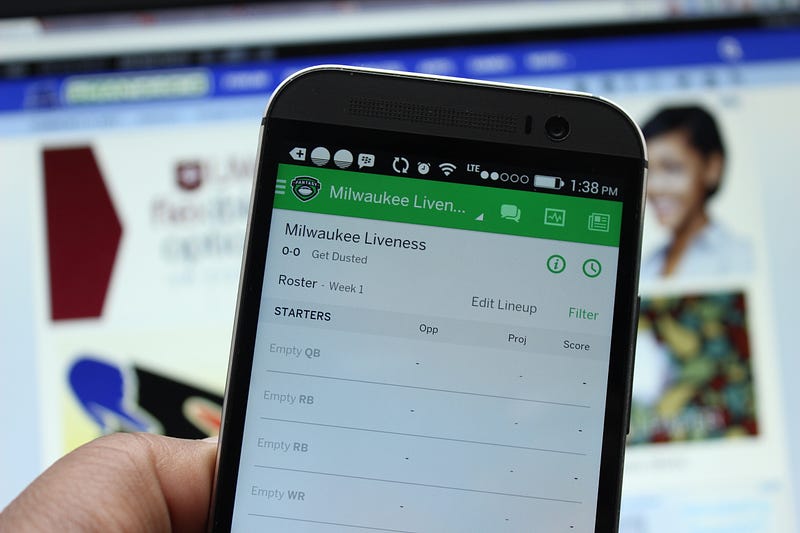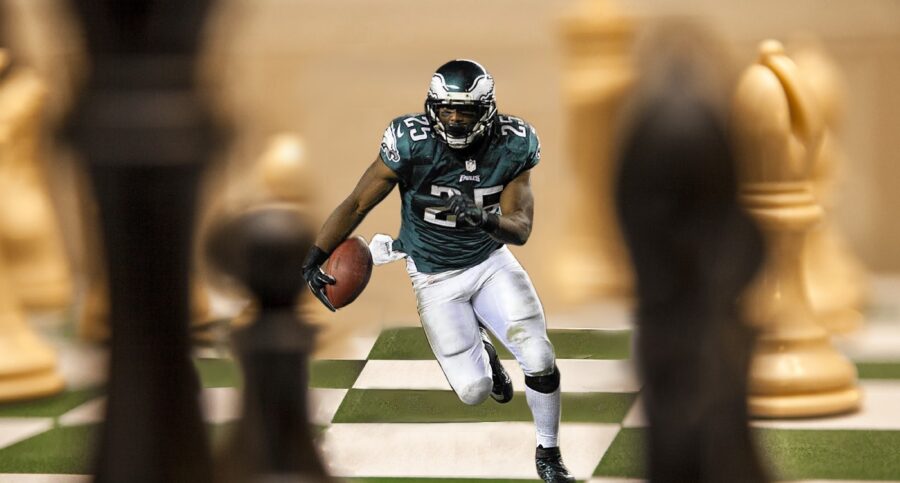Putting the reality back in football
Fantasy football has changed the way we view football and turned us into numb, statistic-crazed fanatics
Fantasy football players go through an emotional roller coaster every Sunday with all the loops, drops and rises the typical National Football League week provides. Fantasy football translates the real NFL player’s game statistics into fantasy points which are then added to a fantasy team; however, today some football fans have gotten caught up in the “fantasy” of fantasy football and have lost sight of the reality in the sport as well as the teams and players who make up the league.
The NFL’s official website explains fantasy football like this: You join a league consisting of family, friends, co-workers or just about anybody (you can join a public league on NFL.com in which you are competing against people from around the world who happen to have a computer). Then you draft a team of actual NFL players — mostly offensive skill-position players, along with a team defense. Each week during the regular season, you set a starting lineup based on who your players are facing in their actual NFL games (and, of course, based on injuries, bye weeks and other factors that might come into play). You’ll go head-to-head each week against someone else in your league, accumulating points based on how your players fare in their real-life NFL games. Just like your favorite NFL team, your goal is to win each week in an attempt to reach the fantasy postseason, which is held after the regular season. And just like an actual NFL general manager, you can make trades with other teams and scan the waiver wire in order to make moves to improve your roster. The bottom line is simple: You are the head coach and general manager rolled into one, and your fantasy team now becomes a factor when it comes to watching the real action as joining an imaginary online league with your family, friends or just about anyone. As both the head coach and manager of your fantasy team, your goal is to win enough points to reach the fantasy post season.

During a fantasy football draft, all players in the NFL are placed into a fake free agent pool for your specific league to choose from, where fans can select the top players at each position on the field, mostly offensive skill position players. These drafts can be anywhere from 15–20 rounds each, where each fantasy player selects one NFL player per round. When the final draft pick is made, you can finally stare and drool over the championship team you hope you just compiled. These drafts are vital because one wrong choice during a fantasy draft can significantly change the outcome of the season for a fantasy owner. The manager of each team drafted can be referred to as the fantasy owner, and every week they pick the top players from their team and place them in their starting line-up. Every week two fantasy owners within the same league face off and must pick their best starting line-ups.
All statistics the NFL player records, from a wide receiver catching a pass to a running back rushing the ball for a 15 yard gain, are documented and processed into points. Fantasy Football is not all about the positive statistics. The bad stats are also significant because players can lose points for their fantasy owners. Fumbles, which are more prevalent with running backs and wide receivers, and interceptions thrown by quarterbacks, are the most common way for a fantasy player to lose points. Every week the fantasy players are at the mercy of the fantasy football gods, for they are either tortured watching football because their players are not producing, or he or she is sitting on top if the world as they open their fantasy football app just to a look at their beloved team’s points.
Fantasy football has been around longer than I had ever imagined. The most basic league was started in 1963 by Bill “Wink” Winkenbach and friends Scotty Stirling and Bill Tunnel while stuck in a New York apartment one rainy night while on a three week road trip. Winkenbach was a minority owner of the Oakland Raiders at the time and was in town to watch the Raiders face off against the Bills and Patriots. The first league and rules were not entirely created in one night, but it sparked plans for what is now a billion dollar industry. This eight-team league was named GOPPPL, an acronym for The Greater Oakland Professional Pigskin Prognosticators League. The first pick in fantasy sports history was Oakland Raiders QB George Blanda for the 1963 season and the second pick in that draft was arguably the best football player of all time, Jim Brown.
Over the past 50 years fantasy football has gained notoriety with over 41 million people playing fantasy sports in the USA and Canada. The Fantasy Football Trade Association estimates that 32 million Americans spend $467 per person or about $15 billion in total playing. Roughly, 11 billion flows toward football. The demographic is made up of 80 percent males and 69.4 percent favor football as their fantasy sport. This popularity has led to a TV sitcom based purely off of fantasy football called “The League.” The show premiered on FX in October 2009 and entered its sixth season this September. The semi-improvisational show portrays the outlandish scenarios of fantasy football that main characters Nick Kroll, Mark Duplass and Stephan Rannazzsisi face. The show’s popularity has led to many guest appearances by NFL players like former defensive player of the year JJ Watt and three time first team All-Pro Antonio Gates. I doubt Bill Winkenbach thought his idea for fantasy football would evolve into the monster it has become, or that it would change the way we watch football.
For any fantasy football owners, league draft day is like their second birthday. Matthew Reyes, a 20-year-old business major at California State University Fullerton plays fantasy football because it makes all 16 games a week relevant. “I love talking crap with my friends when my team is putting up points,” he said.
The opportunity to draft your favorite players is unparalleled, and can be rewarding when they produce on the field as you had hoped. But this feeling of success and pride can quickly turn into hatred toward your players if they do not perform. If they become injured, it almost seems as if the player has screwed you over. There have been countless times that I or a friend have started one of our star players and they go down with an injury in the first half. When we see our player put up that horrifying goose egg for points, the yelling and complaining starts. During the fit, not one thought goes to the health of the injured player whose career is possibly in jeopardy.
Players in the NFL today are aware of these fantasy football enthusiasts who could not care less about the player’s health.
Arian Foster, after injuring his hamstring during the 2011 season, posted on twitter “Those sincerely concerned, I’m doing OK and plan to B back by opening day. 4 those worried abt your fantasy team, u ppl are sick.”

Over the past few years, I have noticed this change in myself and in the people I often watch football with. We have become numb to the players wearing the helmets; not caring about their well-being or what their performance has on the outcome of a game. In some instances, we even forget to pay attention to the actual NFL final scores, only showing attention to our fantasy football team’s matchup.
Some players in the NFL today are fantastic fantasy football options, but in reality, the great statistics they accumulate are outweighed by late game mistakes made on the football field. If a quarterback throws for 300 yards and three touchdowns, and has his team winning by a touchdown in the third quarter, all is well for his team in reality and your fantasy team. This can change very quickly if he throws a costly interception or fumbles late in the fourth quarter. Your fantasy team is not affected by a mere two points squandered, but his actual team may have lost the game due to the late game miscue. This puts players into two different categories. Great football players who are clutch and do not make those mistakes, and those who put up great numbers statistically and are fantasy studs but are untrustworthy to their NFL team and could cost them a victory.
Prior to fantasy football, football was black and white; either players produced on the field and the fans loved them, or the player had mental lapses late in the games and cost his team’s victories and fans learned to resent them. There is now a grey area where many players live, because fans do not necessarily want them on their favorite NFL team, but they will surely take them on their fantasy squad.
Today, with all the different players I have or do not have on my fantasy team it makes it almost impossible for me to be completely satisfied because of the different scenarios that can play out in one week of football. In one week in particular, I was matched up against a fantasy owner who had started Arian Foster of the Houston Texans, my favorite running back in the NFL. I wanted him to perform well because I simply enjoy seeing him play and succeed, but on the other hand, I didn’t want him to singlehandedly defeat my team in the process. Luckily that week he played fantastic, scoring multiple touchdowns and rushed for over 100 yards. After each yard he gained, my heart faced a crossroads: Do I celebrate his success or do I throw a fit and yell at the television hoping he hears me and decides to take a break from doing his job?
Fantasy football players face these types of situations almost every week, and this can taint the whole experience of watching football and rooting for your favorite team.
Before becoming entrenched in the fantasy football world, I would typically root for teams that had an effect on the possible playoff positioning of my favorite team, The Dallas Cowboys, showing the loyalty to my squad. Fantasy football can put your loyalty to an NFL team to the test. The absolute worst situation to be in is playing against one of the key players on your real favorite team. You will find yourself at another crossroads. Do you root for the player to do well and help your real team that you have been loyal to for years, win, or do you celebrate when they do not produce the numbers they were initially projected to post, putting your real team in jeopardy?
Fantasy Football has warped our football minds, enlisting us in a fantasy world filled with projections and a constant monitoring of statistics. Some fantasy players seem to forget there are real, living breathing people under those helmets who have lives outside of the game. All the injuries, poor performances and job insecurities that we merely read about on our fantasy football app are actually happening to these players we have become numb to. Fantasy football players need to reconsider the “fantasy” in fantasy football, and get back to the reality of the sport.
Substance is a publication of the Mt. San Antonio College Journalism Program. The program recently moved its newsroom over to Medium as part of a one-year experiment. Read about it here.










